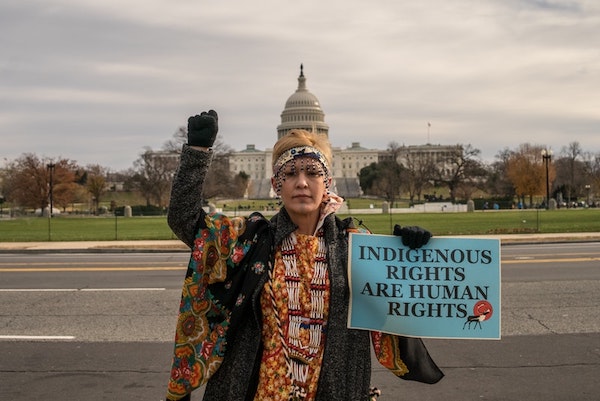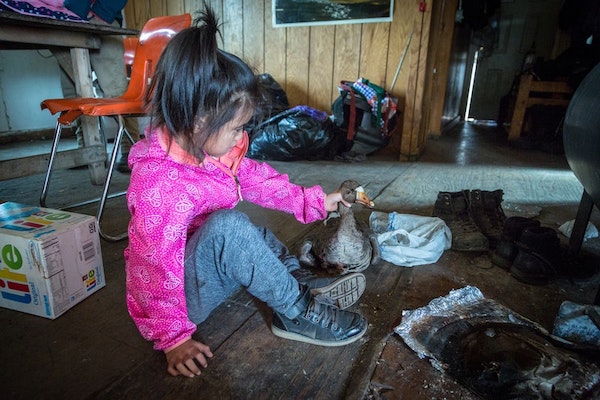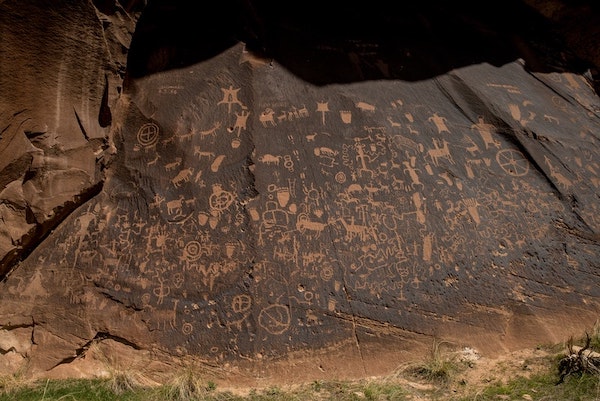Film Review: “The Ground Between Us” — A Way Forward?
By David Daniel
Pitched in this era of hyper-partisanship and sharp division, The Ground Between Us is notable because of the weight and balance it gives to the issues at stake.
The Ground Between Us (62 min.), directed by Zeppelin Zeerip and Galen Knowles. Screening in virtual theaters.

A scene from The Ground Between Us.
The Ground Between Us opens with vintage public service footage of the kind many will remember from schoolrooms of their youth: black & white, soaring music, and an assured voice-over delivering a gloss of history, in this case extolling the treasures of the American landscape: a place between oceans, holding “everything people could need, and wildlife to last an eternity.”
The treasures are real enough, certainly, though the spiel is a bit moldy. Across this landscape, we are told, “the White man rolled, first on wheels of wood, then on wheels of steel — hacking, ripping, gouging as they went — building a mighty nation.” Fade from that. The rest of this story is well known: the open land runs out, some of the native peoples and once-bountiful wildlife are hounded to extinction, and only at last does the government take steps to preserve it “for all people for all time” and make it, as the National Forest Service motto says, a “land of many uses.”
This timely new documentary casts an ambitious wide-screen, full-color gaze on public lands in America — our National Parks and Monuments, wildlife refuges, recreation, conservation, and wilderness areas — making manifest what a gift they are and, simultaneously, examining our deep conflicts over how best to use, manage, maintain, and protect them.
It’s an enormous story, of course, impossible to tell in full, so the filmmakers wisely conceive a tripartite narrative, constructing it around three families grappling with their futures in separate regions of the country. Through an exploration of each of the family units (one Native American, one a Hispanic/White mix, and one White) in its separate locale, a larger picture emerges.
The first story strand is set in Arctic Village, AK. Having become a state only in 1959, and more than twice the size of Texas with a population scarcely larger than Vermont’s, Alaska proffers public lands on a ginormous scale. Much of the territory has been richly productive for oil and gas exploration, and we all benefit from this. The Trans-Alaska pipeline, running from Prudhoe Bay on the Arctic Sea to Port Valdez on the Pacific, is an ambitious symbol of America’s dedication to profit. Production of oil and gas is the major industry in Alaska, and essential to its economy. Yet climate change is proceeding at a more rapid pace there than in many other places.
Arctic Village in the US Wildlife Refuge in the remote northeastern Alaskan coastal plain is home to the Gwich’in Nation of native peoples. To them the land is about culture, spirituality, and tradition. In the ’50s the Eisenhower administration set aside this ancestral land. Dependent on the caribou and salmon of the region, the Gwich’in worry that expanding oil and gas drilling will drive caribou away, divert their breeding habits, and lay waste the land that has been part of their social fabric for over 1500 years. In 1989 Congress came close to further expanding energy exploration in this reserve, until the Exxon Valdez oil spill, an ecological disaster on a giant scale, put a halt to expansion.

A scene from The Ground Between Us.
After decades of citizen opposition to drilling, Congress approved “responsible” drilling in the wildlife refuge. And this past August, despite efforts to legislate against it, oil and gas leasing in the reserve was granted. To the indigenous community, whom we meet in the form of an activist single mom, this is a betrayal. As members of the Gwich’in make plain, however, despite this setback, they will continue, through political means available to them, to press their cause.
It’s a truism that every region of America has its ways of making a living off its land. The question is, can a balance be struck between productive use of land and resources and preservation? This first story strand sets the template that continues in the two stories that follow, taking the macro (timbering in Oregon and cattle ranching in Utah, both on public land) and scaling it down to the micro: the families in each circumstance face the tensions generated by competing forces.
These conflicts are long-standing — government/private interests, preservation/production, eco-systems/traditional ways of life/ local economies under threat — and the list is long. By navigating a neutral path between clashing fronts, the film wisely lets these stories play out through the experiences of individuals and communities under duress. The filmmakers make no overt statements. Each of the family groups, regardless of where it stands, is presented sympathetically. But the dynamics at play are clear. As public land use makes headlines across America, the changing winds of politics threaten to change lives forever.
Different people have different ideas about the use of such lands, and there’s always some vital tension between forces. One of the interviewees compactly observes that “there’s a basic divide between people who think land should always be used and people who think it should always be left alone.” We wonder: can we bridge it? And that is part of the larger question the documentary raises: what do Americans hold sacred? Is it possible to find uniting beliefs in a divided America? Is there, ultimately, common ground?

A scene from The Ground Between Us.
Pitched in this era of hyper-partisanship and sharp division, The Ground Between Us is notable because of the weight and balance it gives to the issues at stake. It avoids the trap of setting up straw men. It doesn’t round up the usual suspects: wild-haired eco warriors, fat cat lobbyists, and bought elected officials (not that these don’t exist; stereotypes come from somewhere). Some elected officials come off favorably: Eisenhower, Clinton, and Obama, for example; others, more through implication than actual indictment, fail (in the current administration’s case, bigly). The choice of people interviewed suggests that there is hope. Representing multiple sides of the divide, none of them are shrill. They are reasonable, caring people, like most Americans, looking for peaceful ways to resolve differences, and fulfill the idea that public land is a land of many uses.
At deeper levels, the film asks: Can public lands somehow be a unifying factor in a fractured America? Could the land-use debate offer a way forward when it comes to bridging other, wider chasms that exist within our national psyche? Given the zero-sum party game our politics has degenerated into, is it possible to find a better way? The film doesn’t take sides, or answer most of its own questions, but it shows that citizens, through advocacy, peaceful protest, and political action, can hammer out effective compromises.
Twenty-five percent of the country is public land, held in trust by Federal and state governments but owned by us, the citizens. It’s abundantly clear that divisiveness is a losing game. Unlike those bland and biased schoolroom documentaries of long ago, The Ground Between Us sounds a call to action. And it’s this: a nonpartisan reminder that, as an election looms, people should vote.
David Daniel is the author of more than a dozen books, including White Rabbit, a novel set in San Francisco in the Summer of Love, and four entries in the prize-winning Alex Rasmussen mystery series. His most recent book is Inflections & Innuendos, a collection of flash fiction. He has been the Jack Kerouac visiting writer in residence at the University of Massachusetts, Lowell, and and blogs regularly at www.richardhowe.com.
Tagged: Alaska, David Daniel, documentary, Natural Parks, preservation

Seventy -five percent of the country’s land is in private (mostly corporate) hands, and that still isn’t enough for them to desecrate. Thanks to Dave Daniel for point it out.